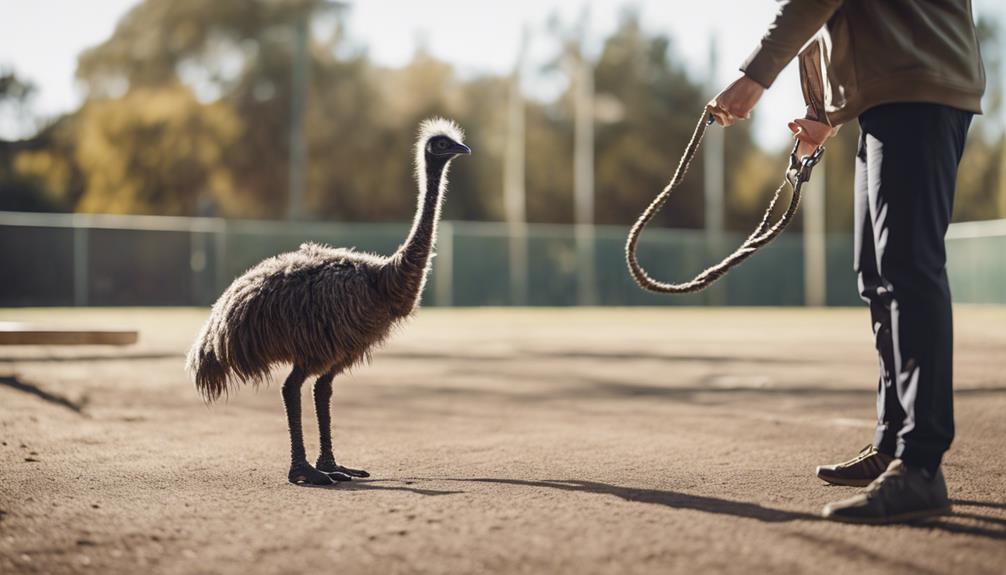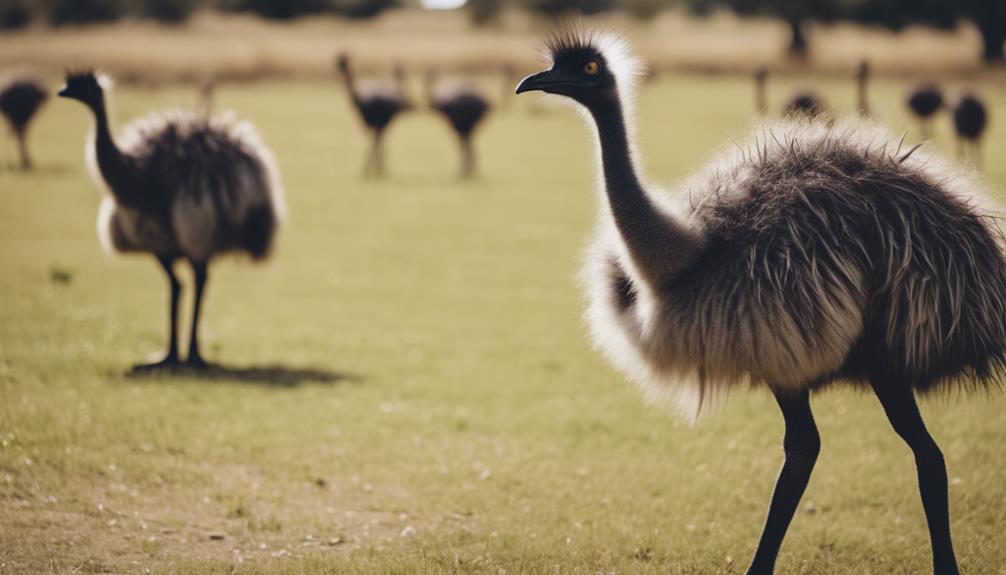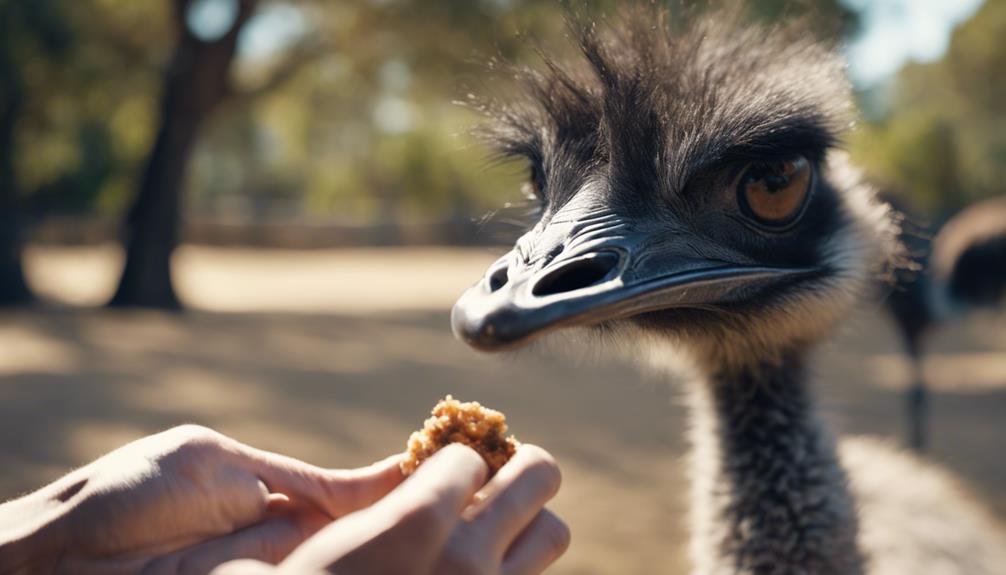
As you delve into the world of emu training techniques, you'll uncover a fascinating realm where patience, understanding, and skill intertwine to create a harmonious bond between trainer and bird. The secrets behind effectively guiding these majestic creatures lie in a delicate balance of communication and respect. By exploring the nuances of their behavior and implementing strategic methods, you can unlock the potential for a rewarding and enriching journey with these unique feathered companions.
Key Takeaways
- Tailor rewards to individual emu preferences for effective positive reinforcement.
- Consistency in applying rewards after desired behaviors is crucial.
- Establish dominance to address behavioral issues and set boundaries.
- Regular interactive sessions enhance bonding, trust, and communication.
- Seek professional advice for insights on emu behavior and training effectiveness.
Understanding Emu Behavior

To effectively train emus, understanding their behavior patterns is crucial. Emus are highly intelligent and social creatures with intricate communication systems. They're known for their inquisitive nature and ability to adapt to various environments. By comprehending their behavioral tendencies, you can establish a strong foundation for successful training techniques.
Emus exhibit a hierarchical social structure within their groups, with dominant individuals leading the way. Understanding this hierarchy is essential when working with emus, as it allows you to establish yourself as a strong and confident leader. Emus respond well to assertive and consistent behavior from their trainers, mirroring the structured dynamics they experience in the wild.
Additionally, emus are highly observant animals, capable of picking up on subtle changes in their environment. It's important to be mindful of your body language and vocal cues when interacting with emus, as they can sense any inconsistencies. By being aware of their keen observational skills, you can ensure clear and effective communication during training sessions.
Setting Training Goals
Understanding the behavioral intricacies of emus lays the groundwork for establishing effective training goals. Emus are intelligent and complex creatures, exhibiting a range of behaviors that can be harnessed through strategic goal-setting. When setting training goals for emus, it's crucial to consider their natural instincts, social hierarchies, and individual personalities. Begin by identifying specific behaviors you aim to modify or reinforce, such as responding to cues, walking on a lead, or participating in health checks. These goals should be clear, measurable, and achievable within a reasonable timeframe to track progress effectively.
Emus respond well to positive reinforcement, so incorporating rewards like treats or praise can help motivate them towards accomplishing training goals. It's essential to break down larger objectives into smaller, manageable steps to prevent overwhelming the emu and ensure steady progress. Regularly reassess and adjust training goals based on the emu's responses and performance to maintain momentum and drive success in their training journey.
Establishing Trust

In the process of establishing trust with emus, observe their body language cues to gauge their comfort level and receptiveness to interaction. Emus communicate through subtle movements and postures, such as maintaining a relaxed stance, soft vocalizations, and gentle eye contact. These signals indicate their willingness to engage with you and build a foundation of trust.
To further solidify trust, approach emus calmly and confidently. Sudden movements or loud noises can startle them, leading to mistrust or fear. Speak to them in a soothing tone and offer treats as positive reinforcement for desired behaviors. Consistent, patient interactions will help emus associate you with safety and rewards, strengthening the bond between you.
Remember that trust is a two-way street. Respect their boundaries and preferences, allowing them to approach you at their own pace. Avoid forcing interactions or invading their personal space, as this can erode the trust you've worked hard to establish. By demonstrating patience, empathy, and understanding, you can cultivate a strong sense of trust with your emus, laying the groundwork for successful training endeavors.
Emu Training Environment
When creating an optimal training environment for emus, consider the layout and design of their living space to promote positive learning experiences and encourage desired behaviors. Emus thrive in environments that mimic their natural habitat, providing ample space for movement and exploration. Ensure that their living area is secure, with sturdy fencing to prevent escapes and protect them from potential dangers. Emus are curious creatures, so offering various enrichments such as logs, branches, and shallow pools of water can keep them engaged and mentally stimulated.
Additionally, the lighting and temperature of the environment play crucial roles in emu training. Emus are sensitive to extreme temperatures, so maintaining a comfortable and consistent climate is essential for their well-being and receptiveness to training. Natural lighting cycles can also influence their behavior, so providing a balance of light and darkness can help regulate their daily routines.
Positive Reinforcement Techniques

To effectively implement positive reinforcement techniques in emu training, consider utilizing a variety of rewards tailored to the individual bird's preferences and behaviors. Emus, like many animals, respond well to positive reinforcement through rewards such as treats, verbal praise, or even access to favorite activities. When training emus, it's essential to understand what motivates each bird to ensure the effectiveness of the reinforcement. Observing their reactions to different rewards can help you determine the most powerful incentives for each emu.
Positive reinforcement works by associating desired behaviors with rewards, encouraging the emus to repeat those actions. Timing is crucial when using positive reinforcement; rewards should be given immediately after the desired behavior to reinforce the connection. Consistency is key in training emus, as they respond well to routine and predictability. By establishing a clear reward system and being consistent in its application, you can effectively shape the behavior of emus through positive reinforcement techniques.
Teaching Basic Commands
Utilizing a consistent and structured approach is essential when teaching basic commands to emus, as it establishes a clear communication framework for effective training. When working with these majestic creatures, remember the following key points:
- Establish Clear Verbal Cues: Use distinct vocal commands consistently to associate them with specific actions.
- Implement Visual Signals: Emus are highly perceptive; incorporate hand gestures or objects to reinforce commands.
- Maintain Firm Posture: Emus respond well to confident body language, so stand tall and assertive during training sessions.
- Reward Correct Responses Promptly: Emus thrive on positive reinforcement; instantly praise or reward them when they follow commands correctly.
- Practice Patience and Consistency: Emus, though intelligent, may take time to learn commands; be patient and maintain a consistent training schedule for optimal results.
Advanced Training Methods

Implementing advanced training methods for emus requires a deep understanding of their behavior and cognitive abilities. Emus are intelligent birds with a complex social structure, making them receptive to advanced training techniques.
One method is target training, where emus learn to touch a designated object with their beak or body part. This can be used to teach them specific movements or positions.
Another advanced technique is positive reinforcement training, where emus are rewarded for exhibiting desired behaviors. This method helps strengthen the bond between the trainer and the emu, leading to more effective training outcomes. Emus can also be trained to respond to verbal cues, associating specific commands with actions.
Training emus in more advanced tasks like obstacle courses or agility exercises can further enhance their cognitive abilities and physical coordination. By gradually increasing the complexity of tasks, emus can continue to learn and grow.
Addressing Behavioral Issues
Dealing with behavioral issues in emus requires a nuanced understanding of their natural instincts and social dynamics. Emus, like many animals, exhibit behaviors that can be challenging to manage, but with the right approach, these issues can be addressed effectively. Here are some key strategies to help you navigate behavioral challenges:
- Establishing Dominance: Emus are hierarchical animals, and establishing yourself as the dominant figure is crucial in addressing behavioral issues.
- Positive Reinforcement: Rewarding good behavior with treats or praise can encourage desired actions and discourage negative behaviors.
- Consistent Training: Emus respond well to consistency, so maintaining a regular training schedule is essential for addressing behavioral issues.
- Environmental Enrichment: Providing a stimulating environment with opportunities for exercise and exploration can help prevent behavioral problems.
- Seeking Professional Guidance: If behavioral issues persist, seeking the help of a professional trainer or animal behaviorist with expertise in emus can provide valuable insights and solutions.
Bonding Through Interaction

To enhance the bond between you and your emu, engaging in regular interactive sessions is key. Interacting with your emu on a consistent basis fosters trust, respect, and a deeper connection. Emus are intelligent birds that respond well to structured interactions, reinforcing positive behaviors while addressing any negative ones. During these sessions, focus on clear communication through body language, vocal cues, and consistent rewards. Establishing yourself as a confident and authoritative figure will further solidify the bond you share with your emu.
Engaging in activities such as grooming, feeding, and even training exercises can strengthen the bond between you and your emu. These interactions create a sense of partnership and teamwork, establishing a hierarchy within your relationship. Emus are social animals that thrive on companionship and interaction, making these sessions vital for their well-being. By investing time and effort in these interactive sessions, you aren't only enhancing the bond with your emu but also promoting a harmonious and respectful dynamic between you both.
Emu Enrichment Activities
Engage your emu in a variety of stimulating activities to provide mental and physical enrichment. Emus are intelligent creatures that benefit greatly from engaging tasks that challenge their minds and bodies. Here are some powerful enrichment activities to keep your emu active and content:
- Obstacle Course Training: Design a course with hurdles, tunnels, and other obstacles to encourage mental agility and physical dexterity.
- Foraging Games: Hide treats or food items around their enclosure to stimulate natural foraging behaviors and keep them engaged.
- Feather Maintenance: Provide opportunities for your emu to preen and groom their feathers, promoting a healthy plumage and fulfilling their natural grooming instincts.
- Social Interaction: Emus are social animals, so introducing them to other compatible emus can provide valuable socialization and mental stimulation.
- Novel Objects: Introduce new objects or toys into their environment regularly to prevent boredom and encourage exploration and curiosity.
Training Progress Tracking

As you continue to engage your emu in various enrichment activities, monitoring and tracking their training progress is essential to ensure their development and well-being. Tracking progress allows you to identify areas of improvement, measure growth, and adapt your training techniques accordingly. A structured approach to monitoring can lead to more effective training outcomes and a stronger bond with your emu.
| Training Aspect | Measurement Tool | Frequency |
|---|---|---|
| Obedience | Time taken to follow commands | Weekly |
| Agility | Completion of obstacle course | Bi-weekly |
| Socialization | Interaction with other emus | Daily |
| Health | Weight monitoring and vet check | Monthly |
Emu Training Safety Tips
Ensuring the safety of both yourself and your emu during training sessions is paramount for successful and productive outcomes. When working with these majestic creatures, follow these crucial safety tips:
- Establish Trust: Build a foundation of trust with your emu through consistent, gentle interactions.
- Use Proper Restraints: Utilize appropriate restraints when necessary to prevent injuries to both you and the emu.
- Stay Alert: Be vigilant and attentive to your emu's body language and signals to anticipate and prevent potential conflicts.
- Avoid Sudden Movements: Emus can startle easily, so move slowly and deliberately to maintain a calm training environment.
- Provide Adequate Space: Ensure there's enough room for both you and your emu to move freely during training sessions to reduce stress and prevent accidents.
Frequently Asked Questions
Can Emus Be Trained to Ride in Vehicles?
Yes, emus can be trained to ride in vehicles. Through consistent positive reinforcement and gradual exposure to the vehicle environment, emus can learn to associate the vehicle with safety and comfort, making it a viable transportation method.
How Do Emus React to Music During Training?
When training emus, consider their reaction to music. Emus may respond positively to certain tunes, aiding in focus and motivation during training sessions. Incorporating music can enhance the training experience, promoting better results.
Are There Specific Toys Emus Prefer for Enrichment?
Emus show a preference for interactive toys that stimulate their curiosity and mimic natural foraging behaviors. Items like puzzle feeders, hanging seed dispensers, and mirrors have been observed to engage emus effectively for enrichment.
Do Emus Respond Differently to Male Vs. Female Trainers?
Do emus respond differently to male vs. female trainers? Research suggests that emus may exhibit varied behaviors based on the trainer's gender. Understanding these dynamics could enhance training outcomes and foster more effective interactions with these majestic birds.
Can Emus Be Trained to Interact With Other Animals?
Emus can be trained to interact with other animals through careful conditioning and positive reinforcement techniques. By establishing clear boundaries and rewarding desired behaviors consistently, emus can learn to navigate social situations effectively.
Conclusion
In conclusion, mastering emu training techniques requires a deep understanding of their behavior, setting clear goals, and building trust through positive reinforcement.
By creating a stimulating environment, engaging in interactive sessions, and tracking progress, successful outcomes in emu handling can be achieved.
Remember to prioritize safety, consistency, and enrichment activities to foster a strong bond with these intelligent birds.
Embrace the journey of training emus with patience, dedication, and a scientific approach for optimal results.




